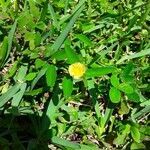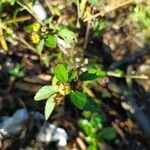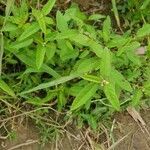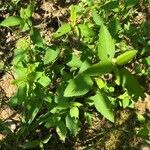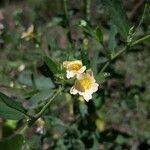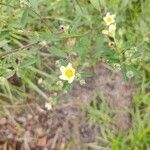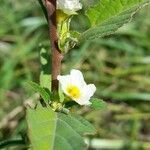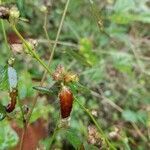Subshrubs or herbs, annual or perennial, 0.2–1 m, rarely taller. Stems erect, minutely stellate-hairy, hairs to 0.5 mm. Leaves: stipules free from petiole, 1-veined, subulate, 3–6 mm, 1/2 as long as petiole; petiole 5–15 mm, usually 1/4–1/2 length of blade, sometimes shorter, minutely stellate-hairy, hairs to 0.5 mm, usually with small spinelike tubercle on stem just below its attachment; blade ovate, lanceolate, or narrowly oblong, 2–6 cm, smaller apically, 2–5 times longer than wide, base subcordate, margins crenate-serrate to base, apex usually acute, surfaces stellate-tomentulose abaxially, glabrate adaxially. Inflorescences axillary solitary or 2–4 clustered flowers. Pedicels 0.5–1 cm, subequal to calyx and subtending petiole. Flowers: calyx angulate, 5–7 mm, minutely tomentose, lobes triangular; petals yellow, rarely white, 5 mm; staminal column glabrous; style 5-branched. Schizocarps subconic, 4–5 mm diam., hairy; mericarps 5, 3–4 mm, somewhat rugose, apex spined, spines 1 mm, antrorsely hairy. 2n = 14, 28.
Branching annual 3–6 dm, commonly with a short spine-like process at the base of each lf; lvs petiolate, 2–4 cm, crenate, lance-ovate to oblong or elliptic, basally subtruncate to subcordate; fls fascicled in the axils; pedicels 2–12 mm, the longer ones jointed near or above the middle; cal thinly stellate; pet pale yellow, 4–6 mm, carpels 5, each tipped with 2 erect, hispidulous beaks; 2n=14, 28. Fields, roadsides, and waste places; pantropical, extending n. occasionally as far as Mass. and Mich. July–Oct.
A herb or small shrub. It keeps growing from year to year. The stems are branched and have a few hairs. The leaves are 2-9 cm long by 6-18 mm wide. They are hairy. The flowers open on sunny days. The fruit are 5 mm across.
Annual or weak perennial herb, up to 1 m high. Petiole armed at base with a hooked spur. Flowers pale yellow.
